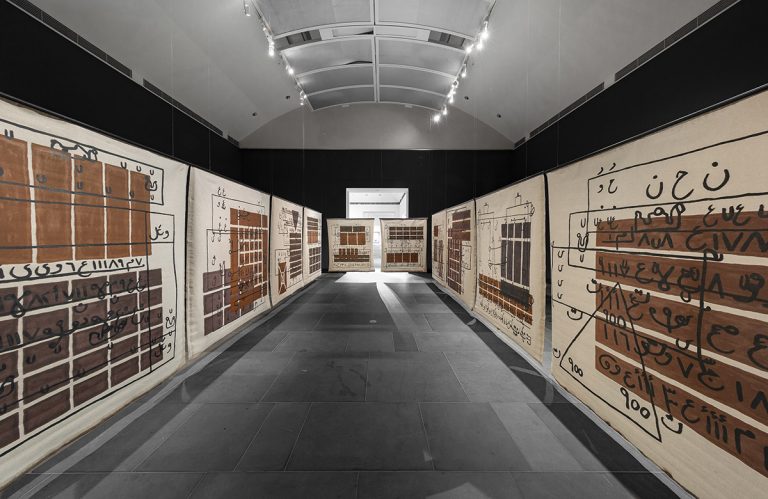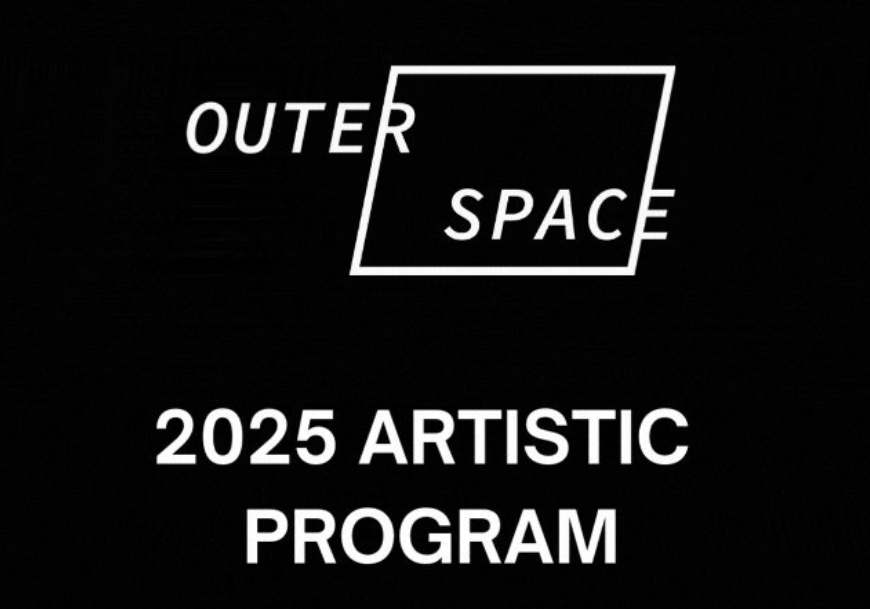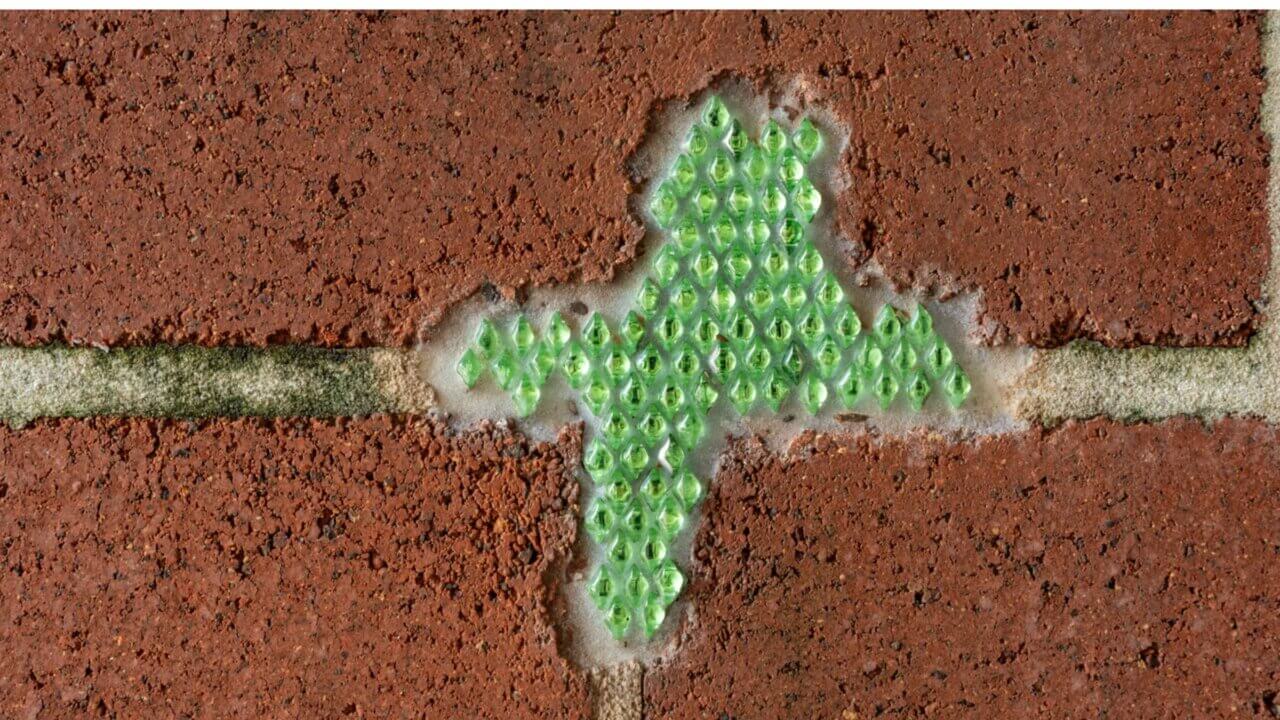
The ten artists in this exhibition have come together in a spirit of a mutual exploration of abstraction. Mostyn Bramley-Moore, Terri Brooks, Michael Cusack, Miles Hall, Anton Hart, Anthony T O’Carroll, Claire Primrose, Amanda Ryan, Peter Sharp and Ann Thompson represent a cross-generational group of Australian artists who have pursued the emotional tenor of abstract forms, lines, colours and textures. Their work ranges from the robust and vigorous to the lyrical and minimal. Some images are sombre, others euphoric, while several works engage with a palpable sense of the familiar urban environment. There are incisions, rubbings and accumulations of matter. Each work is committed to the iteration and reiteration of the mark.
The artists have chosen the exhibition title, Direction Now, intentionally echoing an earlier exhibition that presented a similar spirit of camaraderie. In December 1956 Direction 1 was held at the Macquarie Galleries, Sydney. The commercial gallery presented the work of Robert Klippel, John Olsen, John Passmore, Eric Smith and William Rose. Bound by both friendship and an interest in abstraction, the artists had been particularly struck by the important 1953 exhibition French Painting Today which toured capital cities in Australia and included the work of Picasso and Braque alongside the contemporary artists André Marchand and Pierre Soulages.
Despite positive reviews, this exhibition (which was only on for one week) caused much hostility in the Australian art world. It was not the first time that abstract painting had been exhibited in Sydney, (the Contemporary Art Society exhibitions had regular exhibitors) but it was the first time that an exhibition was dedicated to it. Direction 1 encapsulated a symbolic moment. It was a turning point for abstraction in Australia.
In his review of Direction 1, the artist and critic James Gleeson wrote: “To say that they are invigorating is to do them scant justice. It is as though a fresh wind had blown away the cobwebs. Here is a group of artists who are wholly committed to the elucidation of some of the most difficult problems that artists have ever had to face”.[1] John Olsen has recalled, “Direction 1 came at a time when Australia wanted to participate more in the outside world. It was the time of large-scale, promoted immigration, of the dismantling of the White Australia policy, of greater cosmopolitanism…of a general opening up, a loosening up.”[2] The art critic Paul Haefliger had labelled the artists “leaders of abstract expressionism”[3], although in hindsight it was not the most accurate term to use.
My late father, Elwyn Lynn (texture painter, art critic and curator) had become the editor of the Contemporary Art Society Broadsheet in 1955 where he established a forum for the understanding and appreciation of international art. This was a period when criticism was imbued with a sharp sense of persuasion and passion. There was an atmosphere of relief that the charm of post-war romanticism had given way. He was likely the first person to publish a text about ‘abstract expressionism’ in Australia in 1956.[4] In 1961 he wrote about the “new conviction, a new sense of mission in the approach of abstract painters”.[5] He identified several streams of abstraction: linear expressionism (Peter Upward, Leonard Hessing, Henry Salkauskas, Stan Rapotec, John Olsen, Carl Plate), cubistic articulation (Godfrey Miller, John Passmore, Judy Cassab, Nancy Borlase), texture painters (Sheila McDonald, Oscar Edwards), kaleidoscopic fragmentation and finally, organic growth.
It is almost 60 years since this watershed period in Australian painting, so the question is, why have the artists in this exhibition, Direction Now, chosen to pay homage to this moment in 1956? First and foremost, the exhibition has come together through the artists’ own initiative and developed from a position of mutual respect. Just as the artists in Direction 1 exhibited quite diverse positions, so too this group of artists represents individual voices within the broader field of abstraction. Furthermore, in their joint statement the artists comment that “abstraction is perhaps the least recognized and understood painting form”, suggesting that the exhibition is an entreaty for an expanded dialogue on the topic. The Direction Now artists have persevered with a form of painting/assemblage that has its roots in a modernist period. It was argued in the last decades of the 20th century that abstract painting reached an end point, a limit, in the 1960s with the work of American artist Robert Ryman, and that abstract painting today can only repeat what has gone before. Despite this, abstract painting continues to abound. What if we stepped outside of this debate about the similarities and differences between early and recent abstract painting?
The critic Jan Verwoert has discussed the importance of rhyme and rhythm in contemporary art: when one element corresponds with another without actually being the same thing. While he does not address abstract painting, he contends that “art is about relations rather than representations, about qualities and states, rather than status”.[6] The artists in this exhibition seek to create such qualities and states. They do this through their connection to a sense of place manifested through the material substance of the work. Whether it be the use of contemporary colour, a response to the gritty urbanism of a concrete wall, or the lush Australian coastal foliage, these works relate to the world around them, without seeking to be equivalent to that world, represent it, or take a stance on it. Rather, these objects are of the world they inhabit. The works imbue that world, by drawing on the substances, colours and sensibilities within.
Hence, rather than limiting our consideration to the ‘status’ of abstraction, we can focus on the works themselves, and consider their use of rhyme and rhythm – the relation of parts to the whole. The fragment preoccupies several art forms today: photographic images of ruins, installations with found items, or the trace of an event on video. In the works in this exhibition, the fragment is realised as a single linear gesture, a torn piece of collage, a robust or muted colour or a bulbous form. These fragments are not at ease; rather they are restless. The fragment is always relating to other components in the picture or other works in the group; constantly becoming and dissolving. In the presence of this restless energy of the fragment we, the audience, embark on a process of willing together. We work with the composition – as our eyes dart this way and that, the work remains at the level of ‘relation’. Forms are left floating, unburdened by representation, narrative or illustration. They offer a respite from the images that accumulate around us daily; a breathing space. These artists disclose a respect for process, and for this process to be visible in the layers of paint, or the folding of forms.
Mostyn Bramley-Moore’s luscious circular lines, punctuated by light blue background suggest the turbulence and density of a stormy landscape. The accumulation of circular lines in the work evoke a sense of unexpected movement, changes in light and mood. Peter Sharp’s wide lines meander, like rivers and ridges, through the painting. The imagery is inspired by desert landscapes, and the forms collaborate like a collection of found objects within each work. Ann Thomson’s robust colourful compositions are simultaneously fluid and abrupt. Intense areas of saturated colour are combined with the formless and lyrical addition of dripping paint. Amanda Ryan’s constructed assemblages, by contrast, are quietly folded fabric compositions that explore geometric possibilities. Michael Cusak’s overlapping abstract forms float like clouds, unhinged, in the open and flat space of the canvas. Similarly Miles Hall’s minimal objects hover on the wall in relation to one another, as if torn from a greater whole. Anton Hart’s work uses various media to address our everyday environment. Often using photographic source material, and language, Hart displays an expressionist yet conceptual vigour. Terri Brooks, Anthony O’Carroll and Claire Primrose variously use incised lines, cracked surfaces and rubbed layers to reflect upon an urban, worn and weathered environment. Their works operate at the level of texture, where planes of colour and matter hover and meld into one another. They invoke a sense of place, without describing it, using subdued, and intense colouration.
Unconcerned with being ‘new’, these artists simply exist in the moment ‘now’. This is not a radical or progressive thinking, but a subtle ‘tuning in’. They are ‘tuned in’ to the longevity of abstraction (from expressionism to minimalism) and ‘fine-tune’ their work in a contemporary environment. Linda Marie Walker has written,
Art is a world-making endeavour that can bring unlikely, ungainly, broken, and discarded matters and textures and colours and atmospheres alive… So as to make the world another world, one that is actually present in its own wild imagination, borderless, cosmic, and transitory.[7]
The artists in Direction Now present this transitory and borderless atmosphere. They explore the relational nature of the fragment, allowing it to wrestle with its companion parts. Their materials are infused with a contemporary sense of place, and their work looks at the past from the perspective of the present tense.
Written by Victoria Lynn
From the exhibition ‘Direction Now’ at Caboolture Regional Art Gallery
Victoria Lynn is Director of TarraWarra Museum of Art and has published widely on contemporary art.
[1] James Gleeson, ‘Colour, life in art’, The Sun, Tuesday 4 December, 1956
[2] John Olsen, Drawn from Life The Journals of John Olsen, Duffy & Snellgrove, Sydney, 1997 p.12
[3] Paul Haefleger, ‘Exhibition of Work by Five Leading artists’, Sydney Morning Herald, 4 December 1956
[4] Elwyn Lynn, ‘The Motif in Painting’, Contemporary Art Society Broadsheet, March 1956.
[5] Elwyn Lynn, ‘Avant Garde Painting in Sydney’, Meanjin Quarterly, Vol. 20, No. 3, 1961, p.302
[6] Jan Verwoert, ‘Why is Art Met with Disbelief?’, Nikos Papastergiadis and Victoria Lynn (ed’s), Art in the Global Present, UTSepress and CSR books, Sydney, p.204
[7] Linda Marie Walker, ‘The Tender Heart’, Nikos Papastergiadis and Victoria Lynn (ed’s), Art in the Global Present, UTSepress and CSR books, Sydney, p. 209 citing J. Hillman, The Thought Of The Heart and The Soul of the World (New York: Spring Publications, 1998), p.109.
Image: Mostyn Bramley Moore, Clinton Hill 2015, Oil on polyester canvas









